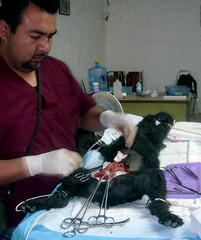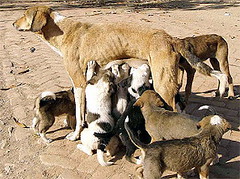
Since I moved to Mexico 6 1/2 years ago I have sought out and found several opportunities to serve the local Mexican population. I was on the advisory board of the Ajijic Women's Co-op for a couple of years. In addition to lending my advice on business practices I was in charge of the micro-loan program.
Last year in February, my friend Susy and I started a program called "Old Ladies Helping Old Ladies". We collect donations monthly from our friends and acquaintances of money, clothing, household items that aren't wanted, etc. to give to Casa Corazon, the homeless women's shelter in a neighboring village. Our goal is to provide funds to run the shelter and pay for a meal served on Saturdays to about 50 homeless (or inadequately housed) Mexicans.
As the homeless in the US, these women only show up when they need a shower or it's raining or cold outside, and of course for the Saturday meal. Unless I go out to the shelter on Saturdays to help with the meal prep, I don't see a lot of results of the work I do. It's very slow progress to make a positive change.
Recently I heard that there was going to be a 3-day, free spay and neuter clinic in another neighboring village. I signed up as a volunteer to do anything that needed doing. My Spanish is composed of phrases and sign language as I can't string a lot of sentences together quickly. So for two of the three days I worked in the surgical area, which is right up my alley.
The little village of Santa Cruz let us use the local meeting building and even hooked up additional electrical plug-ins dropped from the tin ceiling. And the local women provided lunch for us too--not that we had much time to eat or even stop for bathroom breaks.
We had two vets in from Mexico City as well as several local vets from the Lakeside area and Guadalajara give of their time. Donations collected ahead of time paid for most of the materials needed such as tranquilizers, anesthesia, antibiotics, suture material. The county government kicked in hotel and meals for the visiting vets as well as some material. The rest of the material needed like tarps covering the cement floor, plastic to cover the surgical tables, towels/newspapers/cardboard for the recovery area, exam gloves and a whole host of other items were donated by the community or the working volunteers. It's amazing how much stuff is needed just to cut off testicles!! (No jokes about two bricks).
We opened the doors at 8 am to a crowd of people and pets. By the time the last animal was awake and on it's way home the time was mas o menos 6 pm. Then the clean up began to be ready for the next day.
This is the intake area--owners with their dogs and cats. Surprisingly, we had few problems with the interaction of animals. Although, we did have to muzzle a few dogs as they were aggressive to either us or other dogs. In this area a form was completed showing the owner's name, address, dog's name and age/sex. A strong vet student then stood on a digital bathroom scale with the pet in his arms to weigh each animal for Dr. Bob (our local, retired US vet) to calculate anesthesia.
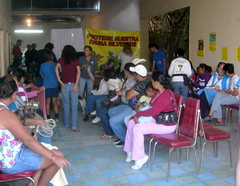
This is the prep area where pets were given a short-term tranquilizer. When the animals were asleep their foreleg was shaved. Two animals at a time could be worked on.
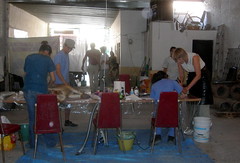
Dr. Bob (in the red shirt and hat)then injected anesthesia into a vein. When the animal was fully asleep the area to be surgerized was then shaved by vet students from Guadalajara and a small vacuum was used to pick up the hair. Disinfectant was then used to clean the area. When a surgery table was free they were transfered to the surgical area.

Here Dr. Abram from Mexico City is spaying a female dog. The organs of dogs and cats are nothing like a human. Animals reproductive organs are more like a long tube in the shape of a "U" with an ovary at each end. The babies are lined up all along the tube (we had a few pregnant animals). The uterus veins, arteries and vagina were tied off, cut, then the organ was removed. The abdominal muscle was then sutured followed by closure of the skin with sutures. They are cleaned of any blood, sprayed with a disinfectant and moved to the recovery table.
With males it's much less involved. A very small slit is made in the scrotum (if a small animal) or at the base of the scrotum. The testicles are then squeezed and pop up through the slit (I know this sounds horrible but because testicles are soooo slippery, it really is the best way, and results in less trauma to the area and less post-op pain to the animal than digging around in there). The connective tissue is retracted, the veins, arteries and tube to the prostrate is tied off before being cut and the testicles are removed. If the slit is in the scrotum there is no suture required--just a spray of disinfectant and they go to the recovery area. If the surgical opening is just ahead of the scrotum, then sutures are placed, disinfectant sprayed and they are off to recovery.
Because male animals were easier and quicker to neuter, I really preferred to see them come in. That way we could see more animals in a day and affect the animal population even more. Surprisingly, there were actually a few men who brought in their males--but mostly it was the women who brought in the animals.
This is the recovery area where the critters were given an antibiotic shot and tattooed on the inside of their rear leg. This was done to identify that they had been neutered for any future vet's information.
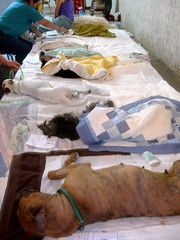
Sometimes, when everything was running very smoothly in each area, we would have 12 animals recovering together. We tried not to put the sleepy cats next to the dogs that were waking up. Dogs wake up pretty quickly like 1/2 -- 1 hour after surgery, but cats take much longer. We had one young cat that was still asleep after 4 hours. We had to rub her vigorously and I ended up carrying her and jiggling her while working the surgical area one-handed. But that was how everyone seemed to be working. We helped each other and worked as a pretty good team.
We even had one local vet who would carry his animal to recovery, clean up his own table and plop his used instruments into the sterilizing tub (nice when two of us were sometimes aiding 5 vets and helping in recovery). He was a fast surgeon and a heck of a nice guy--I'd welcome him back any time!
We also grabbed a few street dogs if they came into the reception area to visit the other dogs. One was a very skinny, little mutt with toenails about 1-1/2 inches long that had curled back into his pads. He had evidently, at one time, been kept in a very small enclosure or tied up on a short rope and wasn't able to keep his nails worn down. His feet were infected and swollen; he hobbled along the street looking for something to eat. Dr. Bob gave him anesthesia to cut his toenails, we neutered him and pumped him full of antibiotics. One of the volunteer ladies took him home to fatten him up, clean him up and socialize him with her dogs. I called her yesterday and he is doing much better and will make someone a good pet when he's put up for adoption.
When everything was totaled up, we had sterilized 175 animals over three days with the majority of them being done by the two visiting vets. No wonder we all went home too tired to eat and fell in bed exhausted.
This was, by far, the most gratifying volunteering I've done since living here. Our work is effecting not only the lives of the pets we saw, but also the lives of the owners. No more baby dogs or cats to feed when it's sometimes difficult to feed the kids. The dogs will be less aggressive, no roaming the town to get hit by a car or out of control donkey cart and they will be healthier.
What a great opportunity I was given to be of help. I plan to work the next clinic planned for this summer. I only hope I survive it!
